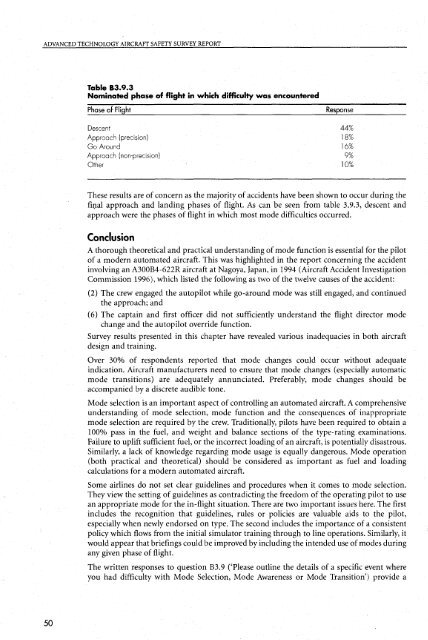Advanced Technology Aircraft Safety Survey Report - Australian ...
Advanced Technology Aircraft Safety Survey Report - Australian ...
Advanced Technology Aircraft Safety Survey Report - Australian ...
Create successful ePaper yourself
Turn your PDF publications into a flip-book with our unique Google optimized e-Paper software.
ADVANCED TECHNOLOGY AIRCRAFT SAFETY SURVEY REPORT<br />
50<br />
Table B3.9.3<br />
Nominated phase of flight in which difficulty was encountered<br />
Phase of Flight Response<br />
Descent 44%<br />
Approach (precision) 18%<br />
Go Around 16%<br />
Approach (non-precision} 9%<br />
Other 1 0%<br />
These results are of concern as the majority of accidents have been shown to occur during the<br />
final approach and landing phases of flight. As can be seen from table 3.9.3, descent and<br />
approach were the phases of flight in which most mode difficulties occurred.<br />
Conclusion<br />
A thorough theoretical and practical understanding of mode function is essential for the pilot<br />
of a modern automated aircraft. This was highlighted in the report concerning the accident<br />
involving an A300B4-622R aircraft at Nagoya, Japan, in 1994 (<strong>Aircraft</strong> Accident Investigation<br />
Commission 1996), which listed the following as two of the twelve causes of the accident:<br />
(2) The crew engaged the autopilot while go-around mode was still engaged, and continued<br />
the approach; and<br />
(6) The captain and first officer did not sufficiently understand the flight director mode<br />
change and the autopilot override function.<br />
<strong>Survey</strong> results presented in this chapter have revealed various inadequacies in both aircraft<br />
design and training.<br />
Over 30% of respondents reported that mode changes could occur without adequate<br />
indication. <strong>Aircraft</strong> manufacturers need to ensure that mode changes (especially automatic<br />
mode transitions) are adequately annunciated. Preferably, mode changes should be<br />
accompanied by a discrete audible tone.<br />
Mode selection is an important aspect of controlling an automated aircraft. A comprehensive<br />
understanding of mode selection, mode function and the consequences of inappropriate<br />
mode selection are required by the crew. Traditionally, pilots have been required to obtain a<br />
100% pass in the fuel, and weight and balance sections of the type-rating examinations.<br />
Failure to uplift sufficient fuel, or the incorrect loading of an aircraft, is potentially disastrous.<br />
Similarly, a lack of knowledge regarding mode usage is equally dangerous. Mode operation<br />
(both practical and theoretical) should be considered as important as fuel and loading<br />
calculations for a modern automated aircraft.<br />
Some airlines do not set clear guidelines and procedures when it comes to mode selection.<br />
They view the setting of guidelines as contradicting the freedom of the operating pilot to use<br />
an appropriate mode for the in-flight situation. There are two important issues here. The first<br />
includes the recognition that guidelines, rules or policies are valuable aids to the pilot,<br />
especially when newly endorsed on type. The second includes the importance of a consistent<br />
policy which flows from the initial simulator training through to line operations. Similarly, it<br />
would appear that briefings could be improved by including the intended use of modes during<br />
any given phase of flight.<br />
The written responses to question B3.9 (‘Please outline the details of a specific event where<br />
you had difficulty with Mode Selection, Mode Awareness or Mode Transition’) provide a
















